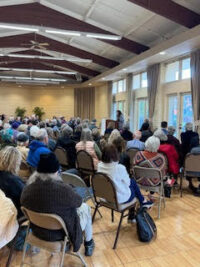Should those who own a 50-year-old or older home inside Sonoma’s historic district need the city’s approval to do such things as increase their home’s size by more than 200 square feet? Or to change the roof’s pitch or add a second story?
Those were some of the questions that the Sonoma City Council was due to study — but take no action on — in a 6 p.m. study session at the council’s Wednesday night meeting.
The Sonoma Design Review Commission proposed the standards to “protect and enhance historic buildings and the city’s historic character.” The historic district includes the northeastern part of the city and also runs along much of Broadway.
The proposed regulations have prompted concern and comment from such groups as the real estate community.
Former mayor Larry Barnett questions the need for the standards.
“Do we want it to be a charming small town or do we want it to be Disneyland?” he asked.
In his column on page 5 of today’s Sun, Barnett writes that variation in home design and style is what makes “Sonoma’s oldest neighborhoods desirable.”
Meanwhile, city councilman August Sebastiani said, “I think the DRC did a great job of putting together a proposal.”
“I think they might have been too specific about a number of things,” he continued.
For example, Sebastiani questioned the idea of applying standards to homes that are 50 years old, suggesting it might be better to pick homes built before a set year, say sometime between 1937 and 1949.
Another critic of the proposed standards is architect Bill Willers.
“The historic character of our town was developed without design review,” Willers said.
“No one likes to have regulation on their property and the more they have, the more upset they get about it,” said Willers.
The eastside’s narrow streets and large trees contribute more to its character than does the architecture of the homes, he said.
“To me, what gives the historic side of town… its character is more the public spaces between the buildings,” Willers said.
Told of Willers’ comments, Sebastiani said, ”I would disagree with him. I think a big part of it is the houses and the architecture.”
As case in point, he mentioned the Fourth Street East’s Craftsman-style cottages that his grandfather commissioned to be built.
Design Review Commissioner Anne Appleman said, “Actually, we’re not making any big changes, we’re trying to make it a little bit more uniform.”
“It’s nice to sort of respect your neighbors and want to blend in, rather than overpower your surroundings,” she said.
Regulating history
More from What's HappeningMore posts in What's Happening »
- Creative Sonoma Announces #TeachTheArts Campaign to Boost Local Teaching Workforce
- The Living Legacy of Mac McQuown
- “Community Call to Action Town Hall” Draws Concerned Residents
- Sonoma Youth Receive American FFA Degrees
- Margaret Hatcher Named 2025 Treasure Artist
- Tenant Rights Town Hall to be held in Sonoma Valley – Dec. 4






